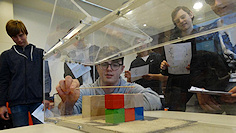Přijďte k nám ve dnech 12., 14. a 16. listopadu 2019, ať vidíte, na čem děláme! Více zde.

First part of the presentation will explain the pressure distributions over the wetted surfaces of a parabolic contour in 2D and an elliptic paraboloid in 3D for oblique water impact. The pressures are calculated by the Wagner model of water entry with focus on zones of the wetted surface, where the hydrodynamic pressure is below the ambient pressure, and the zones, where the pressure approaches the vapour pressure. When the zones of low hydrodynamic pressure approach the contact line of the body surface, the surrounding air flows into this area separating the liquid surface from the body and leading to ventilation. Several models of ventilation and cavitation for 2D problem of oblique impact of rigid and elastic plates will be introduced. The nonlinear 2D problem of oblique impact of an elliptic cylinder onto a thin liquid layer with multiple bouncing of the cylinder from water will be presented. The second part of the presentation is about the water exit problems including the problem of an elastic disc lifted from water surface. The corresponding exit models will be applied to the 3D problem of a rigid ellipsoid gliding on water surface. Comparison of the obtained results with 3D CFD results will be shown. Our exit model of elastic bodies will be compared with the experimental results for large accelerations of the body lifting.
In this talk, we will discuss about classical and new numerical techniques used for parallel/partitioned computations in structural mechanics and also multi-physics or coupled-field problems. In this field, methods based on classical Lagrange multipliers, like the two-level FETI-DP method, have been de facto the preferred parallel algorithms in solid and structural mechanics for decades. However, as we will see, classical Lagrange multipliers also present some limitations. The method of localized Lagrange multipliers (LLM) is a more general coupling technique, that introduces an explicit definition of the problem interface and brings some important advantages. Under this LLM framework, new partitioned algorithms like AFETI-C method are derived from variational principles. AFETI-C uses a combination of rigid-body modes and dominant substructural deformation modes in enforcing the interface force equilibrium equation as constraint conditions. In addition, a regularization of heterogeneities of partitioned systems is appended to AFETI-C that makes it competitive with FETI-DP. These methods, their derivation and their performance will be described, providing a full understanding of the potential of LLM in the solution of coupled problems.